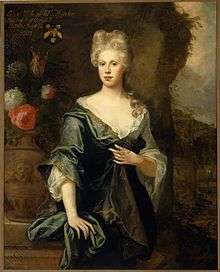William Fytche (MP)
William Fytche (c. 1671–1728) was an English politician, Member of Parliament for Maldon in Essex.[1]
Life
He was the son of Sir Barrow Fytche of Woodham Walter, Essex and his wife Elizabeth, daughter of Sir Mundeford Bramston. After his father died, in 1673, he was brought up by his uncle George Bramston, an academic and judge, and a Tory.[1][2] He appointed William Bramston, brother of George and defender of Anglican orthodoxy, Rector of Woodham Walter in 1686.[3]
Fytche stood for parliament at Maldon in 1698, when he lost to Irby Montagu, brother of Charles Montagu; he was then twice successful in 1701. He dropped out of what was by then a safe seat, intending to pursue a position as an official, with the assistance of Henry St John; but he stood again in 1711, becoming a lottery comptroller, and so resigning his seat. He died on 12 September 1728, at age 57.[1]
Family

Fytche married Mary, daughter of Robert Corey of Danbury: they had five sons and eight daughters. Their youngest son was William Fytche, briefly Governor of Bengal.[1] His wife is elsewhere known as Elizabeth.[4]
Notes
- "Fytche (Fitch), William (c.1671-1728), of Danbury Place, Essex, History of Parliament Online". Retrieved 14 August 2015.
- "Bramston, George (BRMN668G)". A Cambridge Alumni Database. University of Cambridge.
- "Bramston, William (BRMN672W)". A Cambridge Alumni Database. University of Cambridge.
- "Mildmay Records, Seax - Browse Catalogue D/DMy/15M50/224-228". Retrieved 16 August 2015.
| Parliament of England | ||
|---|---|---|
| Preceded by Irby Montagu John Bullock |
Member of Parliament for Maldon January 1701 – 1707 With: Irby Montagu to Nov 1701 John Comyns from Nov 1701 |
Succeeded by Parliament of Great Britain |
| Parliament of Great Britain | ||
| Preceded by Parliament of England |
Member of Parliament for Maldon 1707 – 1708 With: John Comyns |
Succeeded by Sir Richard Child Thomas Richmond |
| Preceded by Thomas Richmond John Comyns |
Member of Parliament for Maldon 1711 – 1712 With: John Comyns |
Succeeded by Thomas Bramston John Comyns |